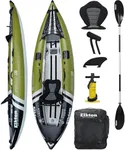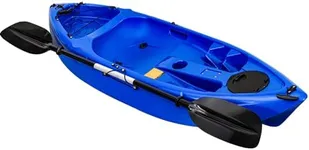Buying Guide for the Best Sit Inside Kayaks
Choosing the right sit-inside kayak can greatly enhance your paddling experience, whether you're exploring calm lakes, navigating rivers, or tackling ocean waves. Sit-inside kayaks offer better protection from the elements and can be more efficient for longer trips. To find the best fit for you, consider the following key specifications and how they align with your needs and preferences.LengthThe length of a kayak affects its speed, tracking, and maneuverability. Longer kayaks (12-16 feet) are generally faster and track better, making them ideal for long-distance paddling and open water. Shorter kayaks (8-12 feet) are more maneuverable and easier to handle, which is great for rivers and tight spaces. Choose a length based on where you plan to paddle and your skill level.
WidthWidth impacts the stability and speed of the kayak. Wider kayaks (over 28 inches) offer more stability, making them suitable for beginners or those who prioritize comfort and balance. Narrower kayaks (under 28 inches) are faster and more efficient, preferred by experienced paddlers who want to cover more distance quickly. Consider your balance and comfort needs when choosing the width.
WeightThe weight of the kayak is important for transportation and handling. Lighter kayaks (under 50 pounds) are easier to carry and load onto a vehicle, which is beneficial if you plan to paddle solo or have limited strength. Heavier kayaks (over 50 pounds) may offer more durability and stability but can be challenging to transport. Think about how you will move and store your kayak when considering its weight.
MaterialKayaks are made from various materials, each with its own advantages. Plastic kayaks are durable and affordable, making them a good choice for beginners and recreational use. Composite materials like fiberglass or carbon fiber are lighter and offer better performance but are more expensive. Inflatable kayaks are portable and easy to store but may not be as durable. Choose a material based on your budget, performance needs, and storage options.
Cockpit SizeThe size of the cockpit affects your comfort and ease of entry and exit. Larger cockpits provide more room and are easier to get in and out of, which is great for beginners or those who value comfort. Smaller cockpits offer better protection from water and can be more efficient for advanced paddlers who want a snug fit. Consider your body size and comfort preferences when selecting a cockpit size.
Storage CapacityStorage capacity is crucial for carrying gear, especially on longer trips. Kayaks with ample storage space, including hatches and deck rigging, allow you to bring along necessary equipment and supplies. If you plan on day trips, a kayak with minimal storage may suffice. For multi-day excursions, look for kayaks with larger storage compartments. Assess your typical paddling trips to determine the right amount of storage.
Skeg/RudderA skeg or rudder helps with tracking and steering, especially in windy or turbulent conditions. Skegs are fixed and can be adjusted to improve straight-line tracking, while rudders are controlled by foot pedals and offer more precise steering. If you paddle in challenging conditions or need help with navigation, consider a kayak with a skeg or rudder. For calm waters, these features may be less necessary.


















